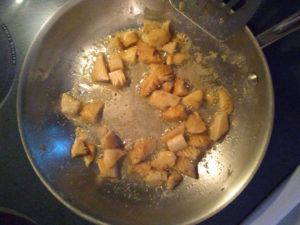By Matt
Part of the adventure of having 27 acres is learning about the wildlife and plants. We’re interested in becoming better stewards and learning how we can sustain the land, as well as gaining knowledge about what is available to sustain us. Mushrooms immediately became a very interesting topic. We have already set up three of our own mushroom ricks using harvested trees, a drill and wood spawn plugs, but thought it would also be interesting to find some wild ones to identify and pick.
Approximately 14 of the 27 acres were previously farmland, which was a mix of corn and alfalfa from 2010 to 2015. The other 13 acres is a mix of plateau land and forest dominated by Box Elder Siberian Elm, Hackberry, Black Cherry and Buckthorn. There are few to no Oaks or Maples currently. There is a seasonal small stream on the eastern border of the property which appears to be the dampest forested portion of the property and this seems to be the location where wild mushrooms would have the best chance of taking hold and fruiting. We looked for Morel mushrooms in the spring but did not find any, probably because they like to grow under Ash, Aspen, Elm, and Oak trees, besides being rare in general.
In the fall as the weather started to turn colder (late September till October) and nights dipped into the high 40’s to low 50’s we observed a flush of mushrooms that appeared in the place where limbs had broken off of Box Elder trees. They had the general appearance of an oyster mushroom but after doing some research turned out to be Hypsizygus ulmarius, the Box Elder mushroom.

But the big question was: was someone going to actually eat them!? There are deadly toxins in some mushrooms that if ingested will lead to symptoms ranging from gastrointestinal distress all the way to organ failure. So one should do copious identification looking at the morphology and colors of the base and stalk, the ring (the area where the cap separated from the stalk when it opened) and the cap and gills (underside of cap). In addition to the online research and using the library, we’re benefiting from the collective expertise found in a Facebook mushroom identification group where we post pictures along with where it was found (tree species, ground type, location in world). Several people usually respond with their best determinations on its identity and edibility.
Mushrooms that have excellent flavors and no adverse biological effects are called “choice” mushrooms. Some people think box elder mushrooms are choice and some do not. I find them to be quite delicious and as you can tell from this blog post: I survived. Sauted in butter for approximately 5 minutes over medium heat, and then mixed into scrambled eggs. Very earthy and meaty.

Two other mushroom varieties that were found on the property had more distinctive features and have no known poisonous look-alike. The first being the Pheasants Back mushroom also called Dryad’s Saddle or Hawks Wing (Polyporus squamosus). The underside has pores instead of gills and as the name implies the mushroom has a kidney-shaped or fan-shaped cap that is colored to look like a pheasants back or hawk wing. Pheasants Back has an odor reminiscent of watermelon that sometimes can carry through to the taste if prepared properly. Prepared fried in butter and with scrambled eggs, I found it added little to the dish other than volume. Others suggest slicing it in thin strips and cooking it hard and fast…. maybe next time.
The second mushroom was quite a find because it looks so different from fungi I had seen before. There were several growing on a decaying log of unknown variety (you can see a chunk of the log on the underside of the specimen) in the bed of the seasonal stream. I popped the best looking one off and took it home to do my research. It was of little doubt that what I had found was a member of the Hericium family of fungi which consists of several species like Lion’s Mane, Comb Tooth and Bears Heat Tooth. This specimen was a Comb Tooth (Hericium Coralloides) fungus. The Hercium family are said to have a lobster/crab/shellfish flavor quality to them and I got a little of that when I made the above scrambled egg concoction with my Comb Tooth. Definitely would have this one again.
